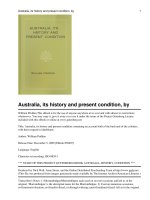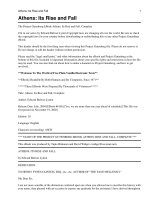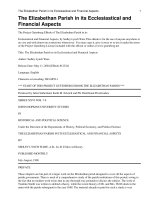hinese soft power through media products its projection and reception in south korea and japan
Bạn đang xem bản rút gọn của tài liệu. Xem và tải ngay bản đầy đủ của tài liệu tại đây (3.17 MB, 313 trang )
CHINESE SOFT POWER THROUGH MEDIA PRODUCTS:
ITS PROJECTION AND RECEPTION
IN SOUTH KOREA AND JAPAN
CLAIRE SEUNGEUN LEE
(M.A. Hankuk University of Foreign Studies, Republic of Korea)
A THESIS SUBMITTED
FOR THE DEGREE OF DOCTOR OF PHILOSOPHY
DEPARTMENT OF SOCIOLOGY
NATIONAL UNIVERSITY OF SINGAPORE
2014
ii
DECLARATION
I hereby declare that the thesis is my original work and it has been written by
me in its entirety. I have duly acknowledged all the sources of information
which have been used in the thesis.
This thesis has also not been submitted for any degree in any university
previously.
________________________________________________
Lee Seung Eun (Claire)
January 2014
iii
ACKNOWLEDGEMENTS
First and foremost, I would like to thank my supervisor, Professor
Chua Beng Huat, who thoroughly supervised my dissertation, and whose
thinking and insight helped me greatly to develop my research and my
writing skills. I would also like to thank Dr. Kurtulus Gemici and Dr. Qiushi
Feng who provided a great amount of useful comments and close readings of
the drafts, and have encouraged me emotionally and academically
throughout this journey. I am really grateful to their time.
I am thankful to be affiliated to and supported by the Asia Research
Institute (ARI) over the course of my PhD. Professor Jean Wei-jun Yeung in
the Changing Family Cluster at the Asia Research Institute and the
Department of Sociology has provided me opportunities to think about my
research from a different angle.
At the Department of Sociology, I extend my gratitude to A/P Ho Kong
Chong, who saw my potential as a sociologist. I would also like to thank A/P
Vineeta Sinha, A/P Syed Farid Alatas, A/P Daniel Goh, A/P Anne Raffin of the
Asian Journal of Social Science team while I was an editorial assistant. To Dr.
Manjusha Nair for offering me to work with her teaching the political
sociology module I offer my gratitude; and to Dr. Ivan Kwek and Dr. Charles
Caroll I thank them for their encouragement and support. Korean sociologists
at the NUS often give me further viable discussion and encouragements: here
I would like to thank Dr. Joonmo Son, Dr. Jiwook Jung, Dr. Juyeon Kim, Dr. Sung
Kyung Kim, and Dr. Jeong-hwa Ho for their support.
I am grateful for A/P Gregory Clancey and Dr. Catelijne Coopmans who
supported and gave me an exciting opportunity to be a part of Tembusu
College.
I would like to thank my fellow graduate students in different
disciplines at NUS: Lee Chih Horng: who sat down with me to discuss society,
iv
and politics, China, and Taiwan, and geared me to think further about my
research. Our monthly discussions with Kathryn Sweet, who became a
historian again, were excellent and refreshing. I am grateful for her thoughts
and encouragements over the years as I am to Minhye, Stefanie, Fiona, Hu Shu,
Allan, Brigit, GY, and others in the department for their presence and support.
Those who read some portions of my thesis carefully, Eugene, Ri An, Bubbles,
deserve my gratitude here. Ambika for our new research interest and
collaboration projects! Other Korean fellow graduate students, Sohee Bae,
Eunsil, Goeun, Mayumi, Yumi, Seonyoung, at FASS.
Two invaluable teachers and intellectual supporters in Singapore
deserve my gratitude. Dr. Wai Keung Chung of Singapore Management
University often gives me his time to discuss, meet and encourage me to use
sociological concepts. I am also grateful for Dr. Soon Keong Ong of Nanyang
Technological University who recognized the importance of studying China
from an external point of view and encouraged me in this regard.
I would like to thank teachers and friends in South Korea, China, and
Taiwan, who have supported me throughout my undergraduate and graduate
studies. My former supervisor Professor Jun Young Kang, Professor Seung Yul
Oh, Professor Jinseok Kang, Professor Lifang Cheng, Professor Dageun Lim, Dr.
Boeun Jeong, and Dr. Seongmin Kim at Hanjuk University of Foreign Studies
in Seoul. I should also thank Professor Yoontae Kim of Dongduk Women’s
University who particularly developed my interest in the sociology of
contemporary China. Professor In Kim of Hanyang University, Professor
Jongmin Won of Cyber Hankuk University of Foreign Studies; Professor
Sujung Nam at Kongju National University, who gave me the great
opportunity to engage with his research project; Professor Shuwei Duan of
Shenzhen University; Professor Chi Ma of Shanghai Academy of Social Science;
Professor Shih Hsiao-Feng, Taiwan Normal University, Dr. Hongbo Wang of
Hong Kong University of Science and Technology.
I extend my special gratitude to Dr. Alec Gordon, my former professor
at Hankuk University of Foreign Studies in Seoul, who knows my research the
v
best and who read and edited endless drafts of my dissertation. I thank him
for seeing my potential as a researcher and for encouraging me to undertake
doctoral studies at the NUS.
For academic support from scholars who I encountered at various
academic conferences during my candidature: Dr. Jia Gao, University of
Melbourne; Dr. Gerry Groot, University of Adelaide; Professor Yun Long and
Dr. Deqiang Ji of the Communication University of China, Professor Colin
Sparks of Hong Kong Baptist University, Dr. Joanna Waters of the University of
Oxford, and Dr. Xin Xin of the University of Westminster. Professor Koichi
Iwabuchi at Monash University, Dr. Philippe Peycam of the International
Institute for Asian Studies, Dr. Young-chul Cho at Leiden University, Prof
Richard Weiner at Columbia University. And I also thank young Scholars who
I met in Germany and Taiwan, Muyi, I-Chih, Stefan, Yihong, and Falk.
I thank my informants in Beijing, Shanghai, Shenzhen, Hong Kong,
Seoul, Tokyo, and Yokohama for their time and sharing their thoughts.
Discussions and exchanges with Ranran, who has known me from my MA to
PhD, were greatly helpful. It was indescribable and thankful to hear that my
MA thesis has developed her newly interest in education and children in
China. Xuehua Yan, my ex-coworker from Hong Kong to Taiwan and friend,
encouraged me to do this research.
My Korean friends Hyangsim, Minji, Junghyun, Seongmin, Yoonsook,
Yoonjung, and Jinju visited me while I was doing my PhD. Sohee, who
coincidently started to work in Singapore, often shared our musical interest
where we met at the university. She amused me with our duo sessions
playing on the flute and violin. These happy moments reminded me of
university life and will be remembered as part of my PhD life at NUS. Also,
popkorn (Pop + Korean + Orchestra), the first and only Korean orchestra in
Singapore, kept me happy, and especially so during the final critical stage of
me writing my thesis. I thank my Korean friends in Singapore, Sung-a, and
Sunhee, for giving me laughter and joy over the course of my doctoral studies.
My proud former students, Namsoon, Heejin, who were in Singapore, along
vi
with Younghyou and Kiheon, Hyejeon, Hannah, Youna, and Ji Young also
helped me keep going and getting closer to my dream.
Last but not least, my internal reader of endless drafts of the
dissertation was Benjamin Gyori. Without him, I would not have been able to
finish this dissertation, neither of the postgraduate life. He taught me to be a
stronger and confident person. His multilingual abilities, critical, and logical
thinking has taught me a lot. His family in Budapest—Professor Marta Fulop,
Professor Janos Gyori, Nagyapo, Nagyi, David, Noemi, and Gergely also
supported me a great deal.
Studing for a PhD culminating in writing a thesis has been a big life
challenge but simultaneously has brought me joy and happiness. Coming
from a family with a former university president as grandfather and a former
medical school professor as a father fostered in me the ineluctable
commitment to pursue academic study to the highest levels. I am indebted to
their paternal influence and support. Mention should be made of my dear
maternal grandmother, who passed away in September 2010, only after a
semester when I started my doctoral studies. My academic success was
always at the forefront of her thoughts about me.
Finally I should thank my parents, Dr. Sang Bong Lee and Hyesung
Park, and brother Junyeob for their continuous support. This dissertation is
dedicated to my family.
vii
TABLE OF CONTENTS
Declaration ii
Acknowledgements iii
Table of Contents vii
Abstract ix
List of Tables xi
List of Figures xii
Abbreviations xiv
Romanization of Chinese, Japanese, and Korean xv
Glossary of Foreign Terms xvi
CHAPTER 1 1
Introduction 1
1.1 Soft Power and the Rise of China 2
1.2 The research focus 5
1.3 Methodology and fieldwork 9
1.4 Significance of the study 15
1.5 Organization of the study 18
CHAPTER 2 21
Theoretical framework 21
2.1 Conceptualizing Chinese soft power 26
2.2 The theoretical framework 35
2.3 Summary 43
CHAPTER 3 45
The Manufacture of Soft Power in a Globalizing China 45
3.1 Chinese soft power: Culture, history, and industrial path 48
3.2 Building soft power 54
3.3 The institutionalized construction of Chinese soft power 67
CHAPTER 4 70
China’s Use of Soft Power in the Media Sector: 70
Producing and Exporting Commercial Products and International Broadcasting 70
4.1 China’s going global strategy and soft power 72
4.2 Globalizing Chinese media products: Policy, guidelines, and export 73
4.3 International broadcasting: Reaching “global” audience 89
4.4 Summary 100
CHAPTER 5 101
The Media Markets in the Receiving Countries of China’s Soft Power 101
5.1 The dual media market in South Korea 104
5.2 The politics of importing Chinese media products to South Korea 113
5.3 The dual media markets in Japan 126
5.4 The politics of importing Chinese media products to Japan 129
5.5 Summary: Domestic institutions as filters or facilitators of Chinese soft power
145
CHAPTER 6 148
The Consumption of Chinese Media Products and the Reception of Chinese Soft Pow
er 148
6.1 Interests, images, and boundaries 149
viii
6.2 The South Korean audience of Chinese media 156
6.3 The Japanese audience of Chinese media 177
6.4 Discussion and Summary: Byproducts of soft power, unintended consequences of
soft power 189
CHAPTER 7 195
China’s International Broadcasting as Soft Power: 195
A Case Study of CCTV International 195
7.1 International broadcasting as a soft power maker 195
7.2 Managing global CCTV markets in South Korea and Japan 200
7.3 Manufacturing response of CCTV International 204
7.4 Summary 211
CHAPTER 8 215
Conclusions 215
8.1 Key arguments reconsidered 215
8.2 Summary of main findings 217
8.3 In search of typologies of projecting soft power 220
8.4 Chinese soft power: Looking backwards and ahead 223
8.5 The Predicament of building Chinese soft power in South Korea and Japan 224
8.6 Limitations of the study and prospects for future research 227
BIBLIOGRAPHY 230
APPENDICES 273
Appendix 1. Two advertisements 273
Appendix 2: Interviews conducted during the Field Research (By field site) 275
Appendices 3.A and 3.B 283
ix
ABSTRACT
On the now common understanding that with its rapid economic
development China has progressively gained recognition on the world stage,
this thesis aims to offer a sociological understanding of China’s ambition to
project its soft power via media products, and the way in which it is
constructed and received in the target countries. Based on field research
carried out in 2011-2012 in China, South Korea, and Japan, this research
explores the reception of its media products (commercial TV series and CCTV
International) in South Korea and Japan. It considers how China’s projection
of soft power is shaped by the foreign/cultural policy of the PRC and the
receiving country’s setting within the soft power field. The emphasis is on
how commercial media products and state-governed news media are used to
realize China’s cultural globalization strategy in the construction of its soft
power. The argument is proffered that media products, which have potential
soft power influence, are controlled and managed by the state, media
institutions and the market demands of the importing country. It is shown
that the South Korean government usually regulates foreign commercial
media products in order not to give unnecessary exposure of foreign
countries to the Korean society, while the Japanese government does not
have a strong state regulation. Evidence is also given to show that the foreign
media products are not only managed by market structures and media
practitioners’ engagement, but that they are also filtered by accommodating
to the market demands of the society. The study then goes on to show that
locally embedded consumption shapes the South Koreans and Japanese
experience in their understanding, consumption, and reception of Chinese
soft power. This is exemplified in the tug of war between China and other
“Chinese” products (Hong Kongese and Taiwanese) and is well represented in
South Korean and Japanese consumers’ ambivalent and complicated attitudes
towards Chinese media products. The thesis then offers a case study of CCTV
x
International as a medium of Chinese soft power that has found it relatively
difficult to reach foreign audiences due to market structures and
questionable attractiveness to the audiences. It is shown that the market
penetration of CCTV International is restricted to the local market structure,
and the audience’s exposure to the channel is managed by the market
penetration and the perception of the news contents. The conclusions of the
study can be summarized: (1) Soft power is an interactive process in which
both the exporting country and importing country co-produce possible
outcomes to generate soft power influence; (2) China’s policy trajectory and
institutional setting are important for the production of Chinese soft power;
(3) The receiving countries’ market structure and demands, domestic
institutions play an integral role in shaping the soft power field for China;
and (4) The logic of China’s projection of its soft power is highly contingent
on how the media market of the recipients is structured and how the
importing countries perceive China.
xi
LIST OF TABLES
Table 2.1 Three Types of Power
Table 3.1 Trajectories of China’s Soft Power Discourse in the Government
Sphere
Table 4.1 What is Produced on the Chinese Side
Table 4.2 China’s Imports and Exports of Audiovisual and Film: 1997-2010
Table 4.3 CCTV’s Foreign Correspondents in Global Bureaus
Table 7.1 The Location of CCTV-International in the South Korean and
Japanese Markets
Table 8.1 The Varieties of Soft Power Mechanism and Different Paths of Soft
Power Development
xii
LIST OF FIGURES
Figure 1.1 Perceptions of China’s Growing Economy and Military in Japan and
South Korea
Figure 2.1 Mapping the Soft Power Field
Figure 3.1 The Economic Value of China’s Cultural Industry
Figure 3.2 The Development of Soft Power in the Selected Time-frame: 1991-
2012
Figure 3.3 The Contours of the Projection of Chinese Soft Power:
Institutionalized Targets and Objectives International influence and Cultural
Products
Figure 4.1 China’s Plan for Projecting its Soft Power: “Going Out” and
“Entering In” Policies through Outward and Inward Development
Figure 4.2 Standard Themes of Chinese TV Series: What is Produced
Figure 4.3 The Value of Imported and Exported TV Series: 2006-2011
Figure 4.4 The Number of Imported and Exported TV Series: 2006-2011
Figure 4.5 Imported and Exported TV Programs: 2011
Figure 4.6 CCTV-4 Audience Rate: By the Hour
Figure 5.1 The Soft Power Mechanism of the Media Markets in the Receiving
Countries
Figure 5.2 The Current Situation of Korean Broadcasting
Figure 5.3A The Number and Value of Imported TV Drama in the South
Korean Terrestrial TV Market: Major Asian Players Only
xiii
Figure 5.3B The Number and Value of Imported TV Drama in the South
Korean Terrestrial TV Market: The United States Only
Figure 5.4A The Number and Value of Imported TV Drama in the South
Korean Cable TV Market: Major Asian Players Only
Figure 5.4B The Number and Value of Imported TV Drama in the South
Korean Cable TV Market: The United States Only
Figure 5.5 The Japanese Media System
Figure 5.6 Japan’s BS and CS systems
Figure 5.7 The Trend of Gross Sales of “Products for Sale” by Genre
Figure 5.8 DVD and Blu-Ray Products Sales: 2001-2011 (By Genre)
Figure 5.9 The Rental Shop: 1984-2012
Figure 5.10 The Trend of Gross Sales of “Products for Rental” by Genre
Figure 6.1 Reception of Soft Power: From Resources to Receptiveness
Figure 7.1 Situating Knowledge and Consumption: The Dynamics of Viewers
in South Korea and Japan
Figure 8.1 Pathways of the “Co-construction” of China’s Soft Power on Three
Levels of Analysis
xiv
ABBREVIATIONS
BS: Broadcast Satellite
CCP: Chinese Communist Party
CCTV: China Central Television
CPC: the Communist Party of China (CPC)
CS: Communications Satellite
CNY: Chinese Yuan
DOP: Department of Propaganda
GAPP: the General Administration of Press and Publication
GOCPC: the General Office of the Communist Party of China
GOSC: the General Office of the State Council
FDI: Foreign Direct Investment
JVA: Japan Video Software Association
KBS: Korea Broadcasting Station of the Republic of Korea
KOCCA: Korea Creative Content Agency
MBC: Munhwa Broadcasting Station of the Republic of Korea
MOC: the Ministry of Culture
NHK: Nippon Hōsō Kyōkai
PD: Propaganda Department
PRC: People’s Republic of China
ROK: Republic of Korea, or South Korea
RMB: Renminbi
SARFT: State Administration of Radio, Film, and Television
SBS: Seoul Broadcasting Station of the Republic of Korea
SC: The State Council
USD: US Dollar
WTO: World Trade Organization
xv
ROMANIZATION OF CHINESE, JAPANESE, AND KOREAN
NAMES, PLACES, AND DOCUMENTS
The guidelines for the Romanization of the names of persons and places in
local languages—Chinese, Japanese, and Korean—as well as translations of
documents in these languages which were used in the course of library
research, field research, and dissertation writing are as follows.
Note on Chinese
For the Chinese transliterations, the Hanyu Pinyin system is used. Personal
names of those whose origins are from Hong Kong and Taiwan follow their
commonly used English transliterations. A single noun is usually written as a
single unit in Pinyin (e.g. soft power: ruanshili, instead of ruan shi li).
Note on Japanese
The Hepburn system is used for the Romanization of Japanese.
Note on Korean
For the Korean Romanization system, the guideline of the “Romanization of
Korean” provided by the National Institute of the Korean Language is used.
Names of places and people with commonly documented English
transliterations which are different from the above are used according to the
common practice.
Translations
All translations are made by the author unless stated otherwise.
References by Chinese and Korean authors
Asian names, in particular Chinese and Korean names, tend to have a small
range of variations of surnames. In order to avoid confusions, I use the initials
of first names with surnames. The First and Last name order is kept except
for cases widely used in a family-first name order (e.g. Deng Xiaoping).









